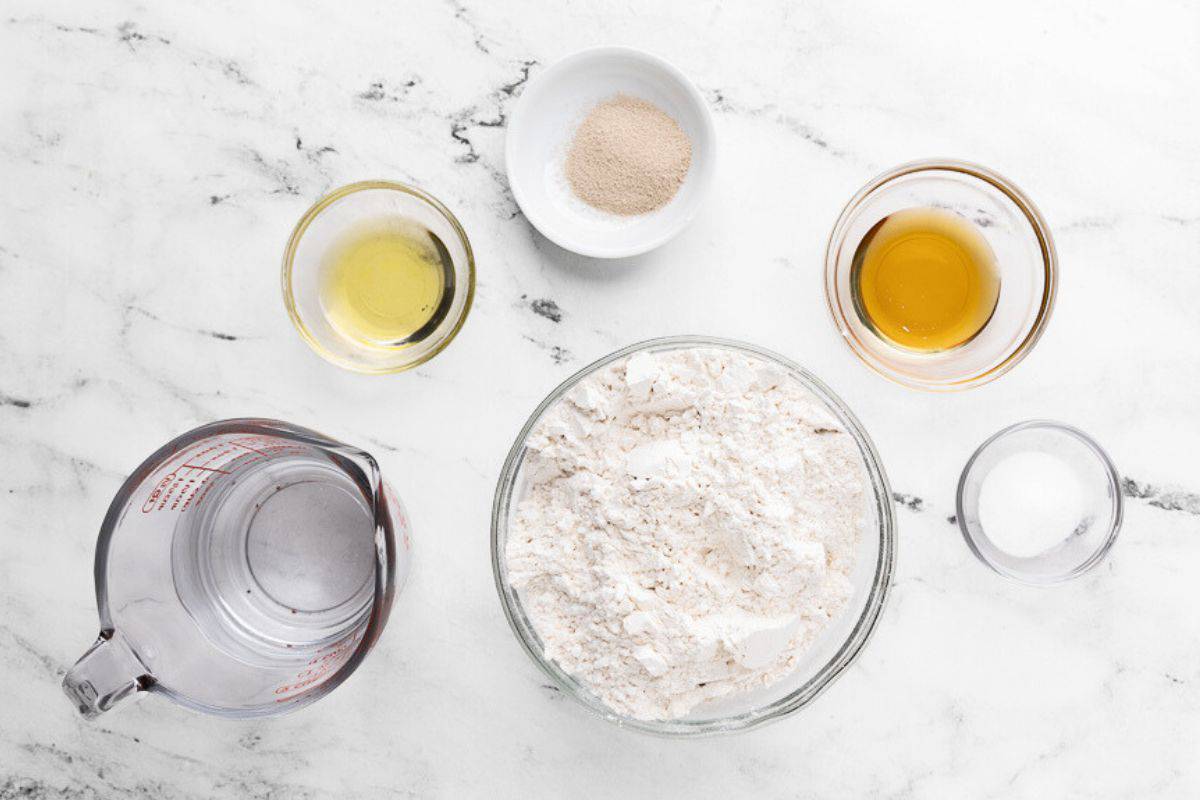French Bread Dinner Rolls
Updated Sep 06, 2025
French Bread dinner rolls are crusty on the outside and soft inside - easy to bake and a great side for soups, salads, pastas or Thanksgiving!
This post may contain affiliate links. Please read our disclosure policy.

Jump to Section
Homemade rolls are the Best!

I always get excited for homemade dinner rolls, but these French bread rolls are extra yum because they have a chewy, crusty exterior similar to French bread but a sweet and fluffy center. The crust is my favorite part of bread so I just love making these rolls to make a dinner feel more special.
I know you might think that making fresh bread from scratch can be intimidating, but these easy French bread rolls are fuss-free and great for any first-time bread baker. Serve them with your Thanksgiving spread for a special occasion or dunk them in some Roasted Tomato Soup.
Happy Baking!
– Yumna
French Bread Dinner Roll Ingredients

- Flour: All-purpose flour is best!
- Water: Use warm water to activate the yeast. If you don’t have a thermometer, test it by carefully dipping a finger in the water to make sure it feels warm but not hot to the touch.
- Honey: I prefer honey but you can try simple syrup, too.
- Oil: I like to use olive oil or avocado oil but melted butter also works in these dinner rolls.
- Instant yeast: Not to be confused with active dry yeast! Be sure to buy instant.
- Salt: Any salt you have on hand will work.
- Cornmeal: This is optional, but it adds great texture!
How to Make French Bread Dinner Rolls
There’s no lengthy rise time for these French dinner rolls, but you should plan for about 2 hours for the entire process, including cleanup.











French Bread Rolls
Ingredients
- 3 ½ cups all-purpose flour divided
- 1 ¼ cups water warm (between 110-120°)
- 2 tablespoons honey
- 2 tablespoons olive oil plus more for bowl
- 2 ¼ teaspoon instant yeast 1 packet
- 2 teaspoons salt
- cornmeal optional
Instructions
- In the bowl of a stand mixer with the dough hook, combine 2 cups of flour, warm water, honey, olive oil, yeast and salt.
- Mix for a few seconds and add the remaining flour, ¼ cup at a time. Knead for 5 minutes at medium-low speed until the dough pulls away from the sides of the bowl and forms a dough ball.
- While the dough is kneading, lightly oil a bowl. Transfer the dough to the oiled bowl and flip to lightly coat. Cover with a kitchen towel or plastic wrap (lightly) and proof the dough has doubled in size, about 45 minutes. Prepare a baking sheet by lining it with parchment paper and sprinkling with cornmeal (optional).
- Once risen, deflate the dough and transfer to a clean work surface. Gently form a ball and cut into 16 equal pieces. Fold the sides of each piece underneath and gently roll on the surface with the palm of your hand and fingers to form a smooth ball. Transfer to the prepared baking sheet and cover with a kitchen towel and allow to rise until doubled in size, about 30-45 minutes. After the final proofing, use a sharp knife to score the top of each roll.
- Preheat the oven to 400°F and place a shallow baking dish with a small amount of water on the bottom rack of the oven. Once preheated, bake rolls for 16-18 minutes, or until golden brown.
Nutrition
Nutrition information provided is an estimate. It will vary based on cooking method and specific ingredients used.
Recipe Tips
- Use your hands if you don’t have a mixer. No stand mixer? No problem! Stir together the dough with a wooden spoon until it all comes together, then use your hands for kneading.
- Don’t over-knead your dough. Kneading activates the gluten in the flour, which is what gives bread its structure. But too much kneading can result in tough, dense rolls. Only knead your dough until it’s smooth and elastic!
- Shape your rolls tightly. When shaping your dough into rolls, it’s not enough to simply roll them into balls. Fold the sides under each roll, stretching them to create some tension. Then roll the dough between your hands. Creating tight balls of dough will help them rise tall, rather than simply expanding outward.
- Score the tops of your rolls. This isn’t just for looks; it serves an important purpose. The steam needs to escape somewhere as the rolls bake! If you don’t score the tops, your dough will decide where to let the steam escape, which will result in rolls that are misshapen and blown out. If it’s sticking to the dough, you can coat the blade with olive oil.
- Don’t forget to create steam. The pan of water at the bottom of the oven is key to getting a French bread crust on these rolls. Without it, the dinner rolls won’t have the crusty exterior.

Serving Ideas
- Serve with pasta. I love using these rolls to sop up any extra sauce in pasta dishes like pasta with cherry tomatoes, spaghetti bolognese, or fetuccini alfredo.
- Eat with soups or stews. I always serve these rolls alongside my instant pot beef stew, lentil stew, or white bean soup.
- Pair with protein. These would be great with my roasted whole chicken or pan-seared steak with butter sauce or even your Thanksgiving Turkey.
FAQs
Let your rolls cool completely, then store them in an airtight container at room temperature for up to 3 days. To reheat, wrap them in foil and place them in the oven at 350ºF for 5 to 10 minutes.
You can freeze these rolls either before or after baking. To freeze before baking, shape the rolls and place them on a baking sheet lined with parchment paper. Freeze until solid, then transfer the balls of dough to a freezer bag or airtight container for up to 3 months. When you’re ready to bake, let them thaw for about an hour before following the recipe’s instructions.
To freeze after baking, let the rolls cool completely, then place them in an airtight container in the freezer for up to 3 months. You can let them thaw at room temperature and enjoy them that way, or warm them up in the oven.
How do I know my yeast is active?
Using warm water between 110-120°F should activate the instant yeast. However, if you’re unsure about the viability of your yeast, you can test it by mixing it with a bit of warm water and a pinch of sugar. If it froths up within a few minutes, it’s good to go.
Why are my homemade rolls tough?
Over-kneading and under-proofing your dough can result in tough, dense rolls. If your house is chilly, you may want to let the rolls proof in the microwave, your pantry, or even in the oven with the pilot light on to protect the dough from drafts of cold air. This will help make sure that they proof in a reasonable amount of time.
There are several possible reasons why your dough may not be rising. Your water temperature might’ve been too hot or too cold, affecting yeast activation. Or, you might be using expired yeast. Also, make sure your dough is in a warm, draft-free environment for effective proofing.








Comments
Hey Yumna!
Do you NEED to use the dough hook attachment for this recipe? Thank you for your time! I love your recipes!
Can you freeze these?
Yes! To freeze after baking, let the rolls cool completely, then place them in a freezer bag or container. They will keep for up to 3 months. You can let them thaw at room temperature and enjoy them that way, or warm them up in the oven.